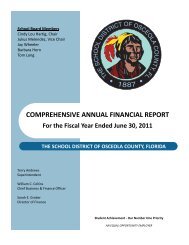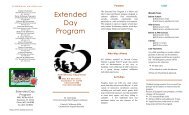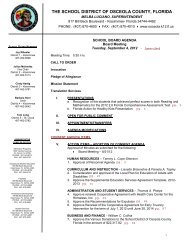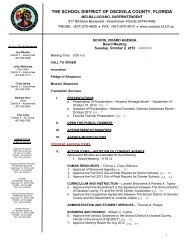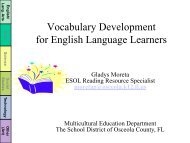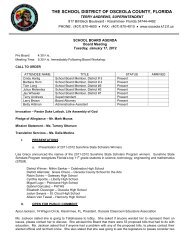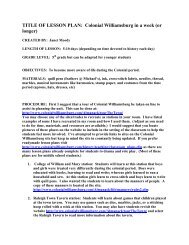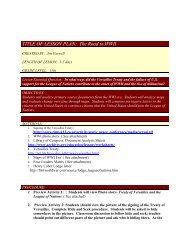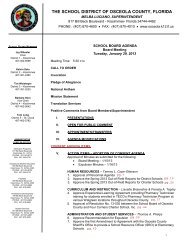2013-2016 Technology Plan - Osceola County School District
2013-2016 Technology Plan - Osceola County School District
2013-2016 Technology Plan - Osceola County School District
You also want an ePaper? Increase the reach of your titles
YUMPU automatically turns print PDFs into web optimized ePapers that Google loves.
2.0 General Introduction/Background<br />
The general introduction/background component of the plan should include, but not be limited<br />
to:<br />
2.1 <strong>District</strong> Profile-Provide relevant social, economic, geographic and demographic factors<br />
influencing the <strong>District</strong> implementation of technology<br />
<strong>Osceola</strong> <strong>County</strong> encompasses an area of Central Florida that has undergone significant change in<br />
recent years. The United States Census estimates <strong>Osceola</strong> <strong>County</strong>’s population at 268,685<br />
residents for 2010. Bouts of explosive growth over the last few decades have resulted in an<br />
increase of 149% from the population of 107,728 in 1990. Many factors and events have shaped<br />
the county since its founding in 1887, but the arrival of Walt Disney World surely represents one<br />
of the most defining milestones. These sprawling, nearby theme parks and resorts transformed<br />
<strong>Osceola</strong> <strong>County</strong> from a small, rural community with a population of 25,267 in 1970 to the everchanging<br />
community it is today.<br />
<strong>Osceola</strong> <strong>County</strong> is a 1,506 square mile area that serves as the south/central boundary of the<br />
Central Florida greater metropolitan area. Although officially considered suburban in nature, an<br />
urban area in the northwest quadrant dominates <strong>Osceola</strong> <strong>County</strong>’s geography. This area adjoins<br />
Polk, Orange, and Lake Counties and includes most of <strong>Osceola</strong>’s population. It encompasses the<br />
communities of Poinciana, Buenaventura Lakes, Celebration, and unincorporated areas ranging<br />
from Narcoossee and Harmony in the northeast to Campbell City and Intercession City in the<br />
southwest to Deer Run and St. Cloud Manor in the southeast.<br />
Not surprisingly, because of the county’s proximity to numerous tourist attractions, scores of<br />
county residents work within the hospitality and service fields for minimum wage. Income<br />
statistics reflect the low-paying jobs many people hold. Based on the 2009 United States Census<br />
estimate, the median household income is $42,626, below the national median of $44,755. The<br />
estimate of people living below the poverty level is 15.8%. A significant 67.6% of the student<br />
population qualifies for the free/reduced lunch program. According to the United States<br />
Department of Labor’s Local Area Unemployment Statistics for October 2011, <strong>Osceola</strong> <strong>County</strong>'s<br />
unemployment rate had reached an overwhelming high of 10.8%.<br />
One of the most interesting county characteristics is <strong>Osceola</strong>’s racial and ethnic diversity. The<br />
most recent data available (2011-2012 school year) for the racial makeup of the <strong>District</strong>’s 54,448<br />
students reflects the diversity, with 27% White, 11 % Black, 52% Hispanic, 3% Asian/Pacific,<br />
1% American Indian or Alaskan, and 6% Multi-Racial. The <strong>District</strong>’s culturally diverse<br />
community represents 107 countries and involves use of 94 different languages. Accordingly, a<br />
significant portion of the student population (25%) is “Limited English Proficiency” (LEP) in<br />
2011-2012, and 14% of the population is comprised of “Students with Disabilities.”<br />
Overall, in spite of various gains, students’ 2011 Florida Comprehensive Assessment Test<br />
(FCAT) results show a pattern of achievement that consistently falls below state averages. For<br />
reading, 68% of district elementary school students scored Level III or above, while the state<br />
average is 71%. Similarly, 59% of district middle school students and 36% of district high school<br />
(grades 9 and 10) students scored Level III or above in reading, but the state reports higher<br />
averages of 63% for middle school and 44% for high school. In mathematics, percentages of<br />
district students achieving Level III or greater are 64% for elementary school, 52% for middle<br />
school, and 64% for high school (grade 10). Once again, state averages were higher with 72% for<br />
elementary school, 62% for middle school, and 71% for high school. On the science portion, 49%<br />
2<br />
<strong>2013</strong> Educational <strong>Technology</strong> <strong>Plan</strong> <strong>School</strong> <strong>District</strong> of <strong>Osceola</strong> <strong>County</strong> Florida



